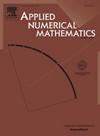Point-wise error estimates of two mass- and energy-preserving schemes for two-dimensional Schrödinger–Poisson equations
IF 2.4
2区 数学
Q1 MATHEMATICS, APPLIED
引用次数: 0
Abstract
This work presents two implicit and linear finite difference schemes that simultaneously preserve both mass and energy conservation properties for the two-dimensional Schrödinger–Poisson equations. The conservation, existence, uniqueness, as well as the convergence to the exact solution with the order in discrete and norms are established for these two schemes, where and represent temporal and spatial step sizes. In contrast to the existing analysis techniques that rely on an a priori estimate of numerical solutions or impose restrictions on initial data, our approaches guarantee the unconditional convergence for SP equations with both attractive and repulsive forces. Besides the standard energy method, our analytical framework employs the cut-off method for the implicit scheme and the mathematical induction argument for the linear scheme, where the “lifting” technique is utilized in the two schemes to eliminate the constraints on grid ratios. Numerical experiments are provided to illustrate discrete conservation properties and validate the achieved convergence results.
二维Schrödinger-Poisson方程的两种质量和能量守恒方案的点误差估计
这项工作提出了两种隐式和线性有限差分格式,同时保持二维Schrödinger-Poisson方程的质量和能量守恒性质。建立了这两种格式在离散L2和L∞范数下的守恒性、存在性、唯一性以及对O(τ2+hx2+hy2)阶精确解的收敛性,其中τ和hx、hy分别表示时间和空间步长。与现有的依赖于数值解的先验L∞估计或对初始数据施加限制的分析技术相比,我们的方法保证了具有吸引力和排斥力的SP方程的无条件收敛。除标准能量法外,我们的分析框架对隐式方案采用截止法,对线性方案采用数学归纳法,其中在两种方案中使用“提升”技术来消除对网格比率的约束。数值实验验证了该方法的离散守恒性和收敛性。
本文章由计算机程序翻译,如有差异,请以英文原文为准。
求助全文
约1分钟内获得全文
求助全文
来源期刊

Applied Numerical Mathematics
数学-应用数学
CiteScore
5.60
自引率
7.10%
发文量
225
审稿时长
7.2 months
期刊介绍:
The purpose of the journal is to provide a forum for the publication of high quality research and tutorial papers in computational mathematics. In addition to the traditional issues and problems in numerical analysis, the journal also publishes papers describing relevant applications in such fields as physics, fluid dynamics, engineering and other branches of applied science with a computational mathematics component. The journal strives to be flexible in the type of papers it publishes and their format. Equally desirable are:
(i) Full papers, which should be complete and relatively self-contained original contributions with an introduction that can be understood by the broad computational mathematics community. Both rigorous and heuristic styles are acceptable. Of particular interest are papers about new areas of research, in which other than strictly mathematical arguments may be important in establishing a basis for further developments.
(ii) Tutorial review papers, covering some of the important issues in Numerical Mathematics, Scientific Computing and their Applications. The journal will occasionally publish contributions which are larger than the usual format for regular papers.
(iii) Short notes, which present specific new results and techniques in a brief communication.
 求助内容:
求助内容: 应助结果提醒方式:
应助结果提醒方式:


